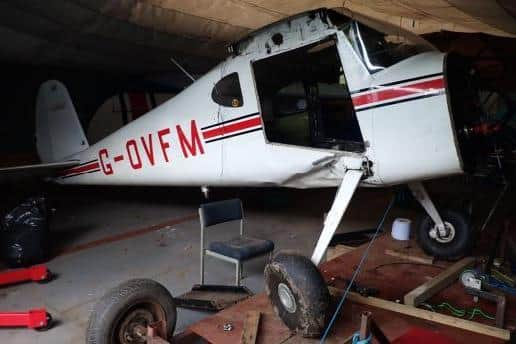Pilot, 20, crashed private aircraft at Yorkshire airfield then failed to report accident
On December 6 last year, the 20-year-old pilot was bringing his Cessna light aircraft, manufactured in 1948, in to land at South Cave Airfield near Hull after a flight to Sherburn-in-Elmet in North Yorkshire.
The plane landed at speed on a downhill wet grass runway and failed to stop, striking a hedge beyond it.
Advertisement
Hide AdAdvertisement
Hide AdThe pilot and his passenger were uninjured, but did not report the accident as they are obliged to do so under aviation rules.


The AAIB report, published last week, reads: "The pilot, accompanied by a passenger, was returning to the airfield having flown to Sherburn-in-Elmet for a private flight earlier that day. As they arrived the pilot overflew the runway to view the windsock. This indicated that the downhill1 Runway 25 was most favourable. The pilot positioned for the runway and commenced his final approach. The approach was quick and resulted in touching down further along the runway than normal. As the pilot applied the brakes, the wheels, which were equipped with slick tundra tyres, skidded.
"At this point the pilot realised he was unlikely to stop on the runway. He made an assessment that there was insufficient distance to get airborne and clear trees beyond the end of the runway so elected to continue with the landing. As expected, he was unable to stop the aircraft before colliding with a hedge at the end of the runway. Both the occupants were uninjured. The pilot believes that between the time that he departed from South Cave (Mount Airy) and his subsequent return to the airfield rain showers, which were forecast, had wetted the grass runway, and made it slippery, increasing the landing distance of the aircraft.
"In addition, the pilot was accustomed to flying G-OVFM solo and was not used to flying with a passenger which had brought the aircraft close to maximum takeoff mass. The pilot stated that he was also used to flying a Cessna 172, which slowed more rapidly with the use of flaps, a control that the Cessna 120 is not fitted with.
Advertisement
Hide AdAdvertisement
Hide Ad"The damaged aircraft was recovered to a hangar and its wings and engine removed in preparation for repair. Subsequent inspection by the AAIB identified the right main landing gear leg was deflected rearwards. This resulted in buckling and twisting of the floor pan and fuselage to the rear of the landing gear mount. The fuselage to the rear of the left seat had buckled and the right wing root had cracked. The engine cowls were damaged, as was the propeller.
"The accident was not reported to the AAIB by the pilot or aircraft owner. It was only when a third party contacted the AAIB, enquiring whether the event was being investigated, that the AAIB became aware of the accident. Non-reporting of an accident is an offence and breach of The Civil Aviation (Investigation of Air Accidents and Incidents) Regulations 2018, Part 2, Regulation 202 . This occurrence serves as a reminder to all pilots of their obligation, as a licence holder, to report accidents or serious incidents, even if they consider the event not to have been reportable.
"The pilot was familiar with the airfield and was flying an aircraft he had flown many times before. With this, he may have been lulled into a false sense of security and may not have planned the flight as diligently as if her were flying to a new location. The changing weather conditions, increased aircraft weight and fast and deep approach combined with the adverse gradient on the landing runway to increase the stopping distance and reduced the brake effectiveness resulting in the runway overrun. If the pilot had considered these factors in advance of the flight and accounted for threat and error management he may have gone around earlier, or accepted a slight tailwind, but uphill landing."
